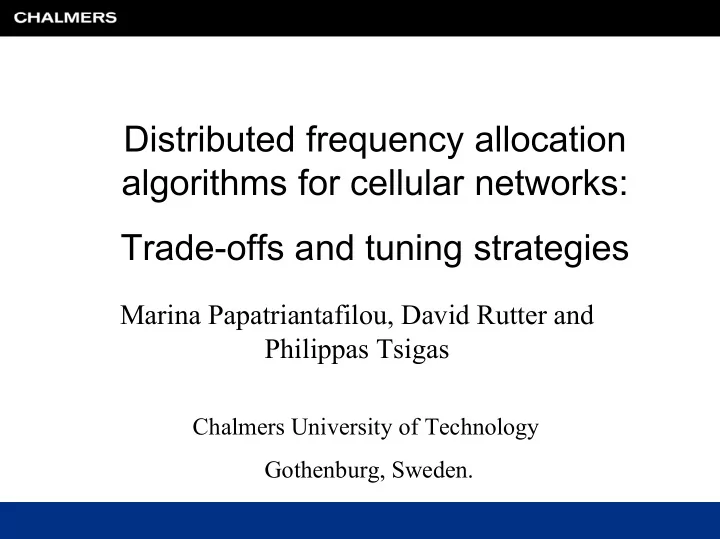

Distributed frequency allocation algorithms for cellular networks: Trade-offs and tuning strategies Marina Papatriantafilou, David Rutter and Philippas Tsigas Chalmers University of Technology Gothenburg, Sweden.
What did we do ? •Frequency Allocation in cellular networks •Distributed solutions: •How do they perform in practice ? •How can we tune them ? •What are the trade-offs ? •What happens when the load is dynamic and non uniform ? •What happens if there are failures in the network ?
Base station Free Freq. 1 Freq. 2 . . Busy . Freq. n
Cellular Network
Deterministic Distributed List Colouring (DET_DLC) •Based on vertex-colouring by Alon & Tarsi and advanced mutual exclusion due to Choy & Singh. •Introduced by Garg, Papatriantafilou and Tsigas.
Randomised Distributed List Colouring (RAND_DLC) •Avoids sychronisation by randomising the frequencies that are chosen by a base station. •Also introduced by Garg, Papatriantafilou and Tsigas.
Tuning Strategies •Dynamically determining the number of frequencies to acquire, and retain. Free Busy
Tuning Strategies Little’s Law: •Mean number of requests at a base station ( λ i T) •LittlesLawStrategy = λ i T-| Busy i | QueueRatio: • min_ratio = min ( λ i T) ≠ 0 • QueueRatio = r i (1+1/ ∆ ))(1- free_ratio ) •QueueRatio Strategy = max ( QueueRatio , min_ratio )
Experiment Design •Network size: 49 cells •Spectrum size: 500 frequencies •Arrival rate: Poisson distribution. Hot-cells λ = 85/min, normal cells λ = 45/min, cold cells λ = 20/min •Total number of requests: 100,000 •Failures: Up to 3 crash failures at arbitrary stations. •Network load: based on hot-cell configurations that are changed during the experiment execution.
The Trade-offs… Response Time Dropped Calls Total Messages Bandwidth Utilisation
Response Time vs Dropped Requests
Total Messages vs Utilisation
Conclusions • By designing appropriate tuning strategies, we can balance the trade-offs so that the performance gains can be substantial, while the losses are small. • Fault tolerance: our results confirm the theoretic results. Also, the tuning strategies actually improve the performance of the algorithms in some respects.
Future Work • To develop algorithms that can make use of the frequency reuse information, while maintaining the performance and fault tolerant properties of the previous solutions. • Continuing the current study, looking at priority schemes, frequency reservation schemes (for hand- offs), etc.
Dropped Requests
Response Time
Bandwidth Utilisation
Total Messages
Recommend
More recommend